Abstract
Animal models of murine respiratory mycoplasmosis due to Mycoplasma pulmonis provide excellent opportunities to study respiratory disease due to an infectious agent. The purpose of the present study was to develop and characterize an aerosol model for the production of murine respiratory mycoplasmosis in mice. The exposure of mice for 30 min to aerosols generated with a DeVilbiss 45 nebulizer in a nose-only inhalation chamber consistently reproduced typical lesions. The chamber was operated with a nebulizer air flow of 5.3 liters/min at 5.0 lb/in and a diluting air flow of 20 liters/min, with the nebulizer containing 5 ml of a suspension of viable M. pulmonis organisms (a concentration between 6 X 10(5) to 6 X 10(10) CFU/ml). Infective aerosol particles of less than a 4.0-micron median aerodynamic diameter with a geometric standard deviation of approximately 2.0 reached the lungs and were evenly distributed among the different lung lobes. A minimum 1.5-log loss of viability in the M. pulmonis suspension was demonstrated. With the exception of the 50% lethal dose, all of the parameters previously established by intranasal inoculation could be examined with the aerosol model. The major advantages of the aerosol model were excellent reproducibility of exposure (both between different experiments and between animals in a given experiment), the avoidance of anesthetization, and the ability to immediately deposit the majority of the organisms in the lung. The only disadvantage was the requirement for large volumes of mycoplasmal cultures.
Full text
PDF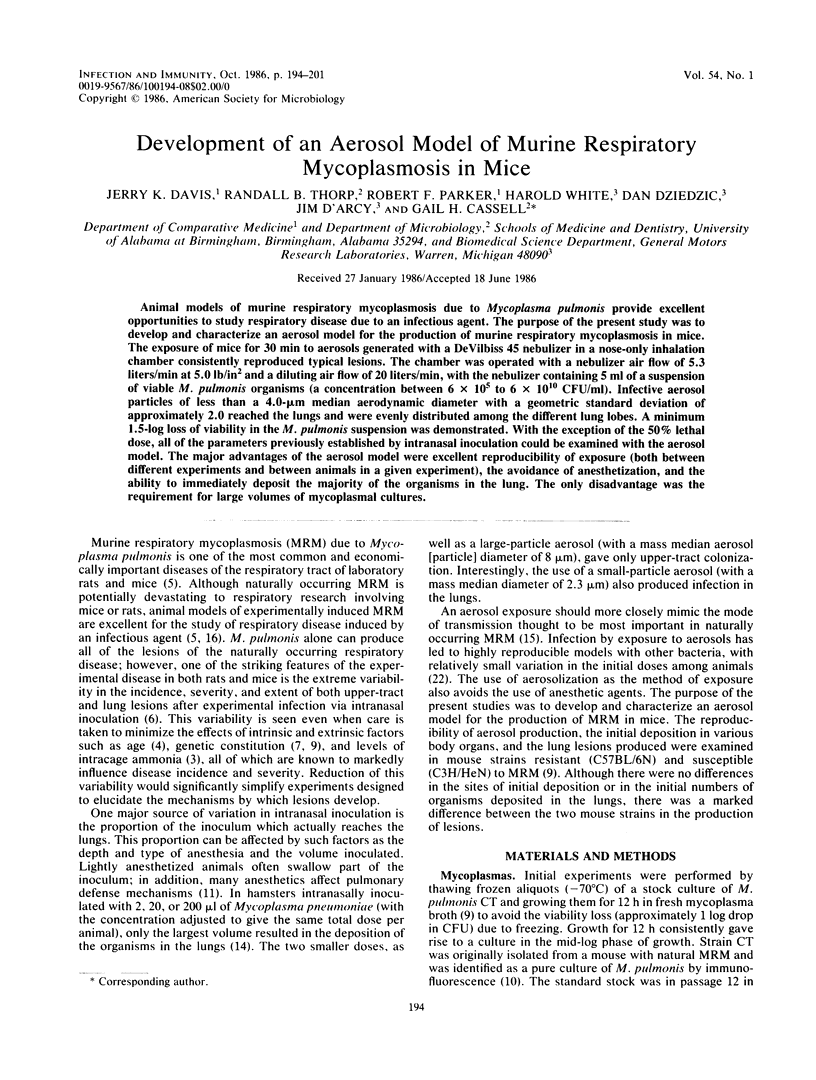
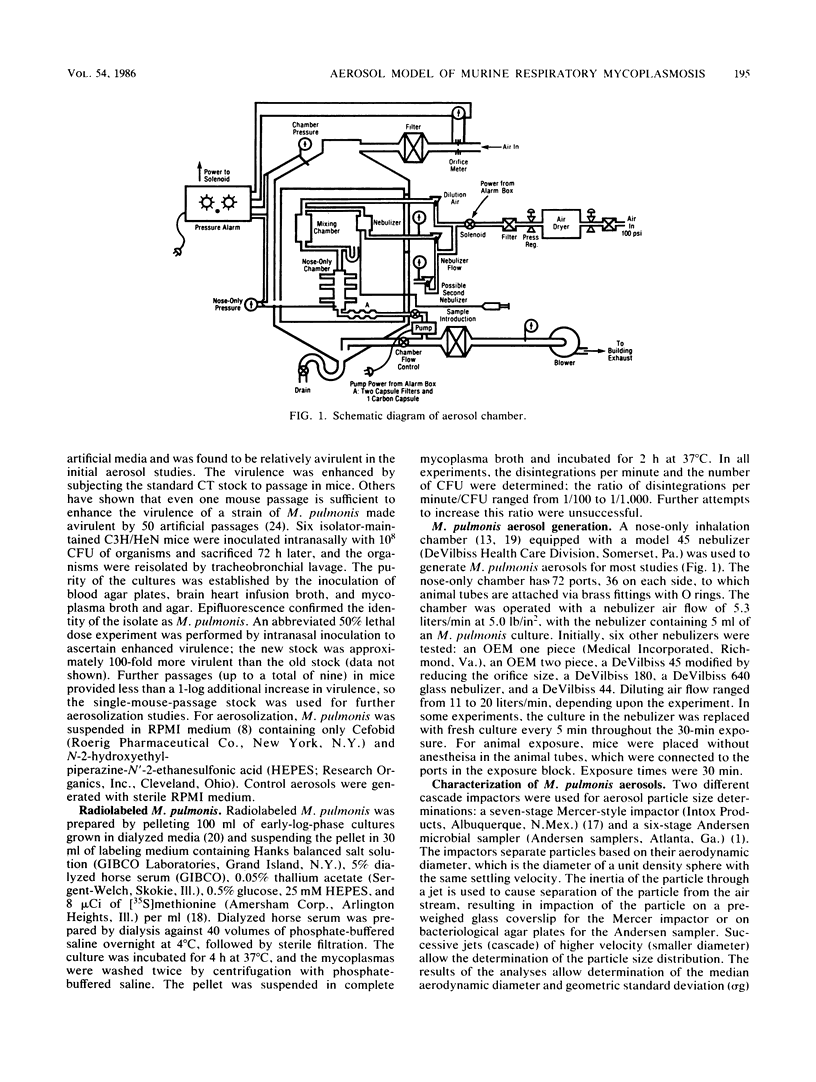

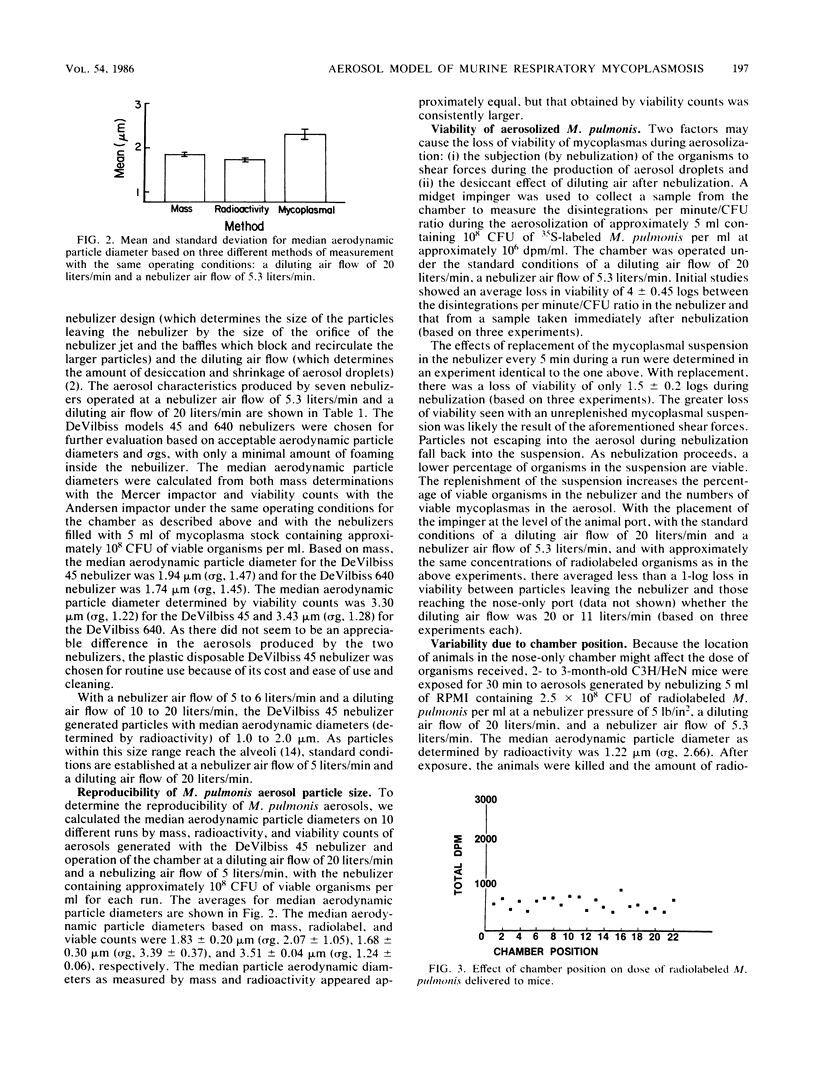
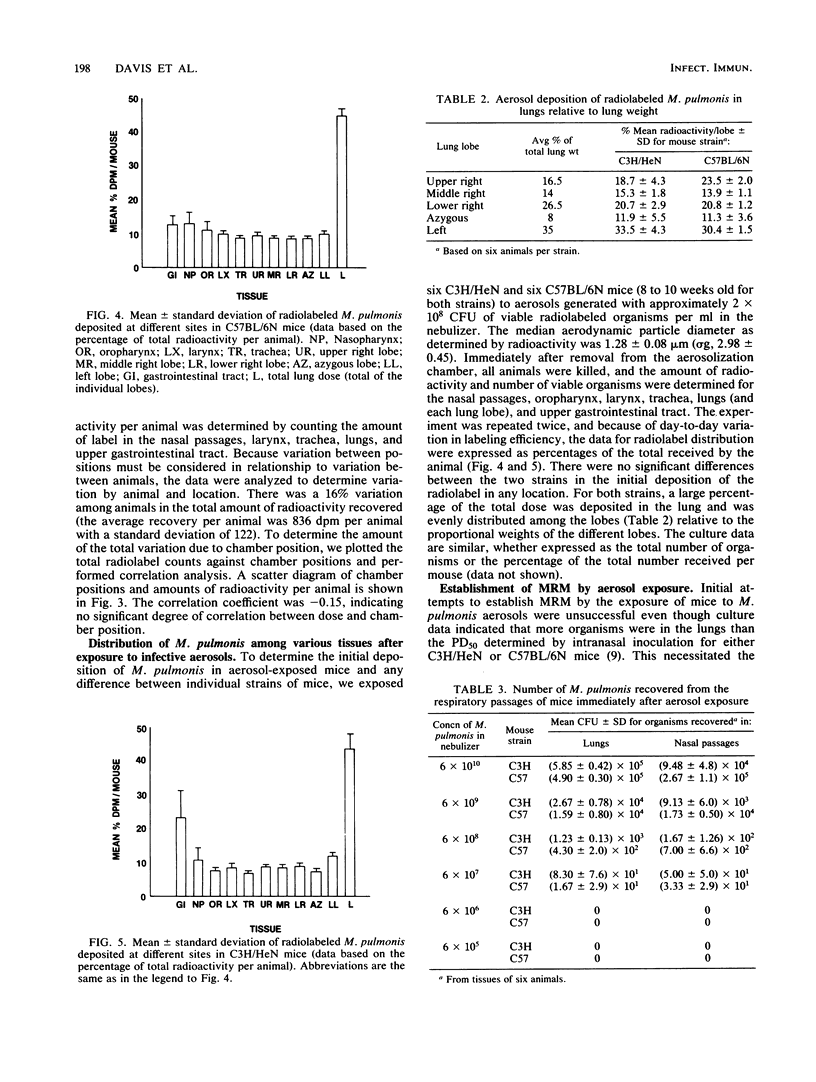
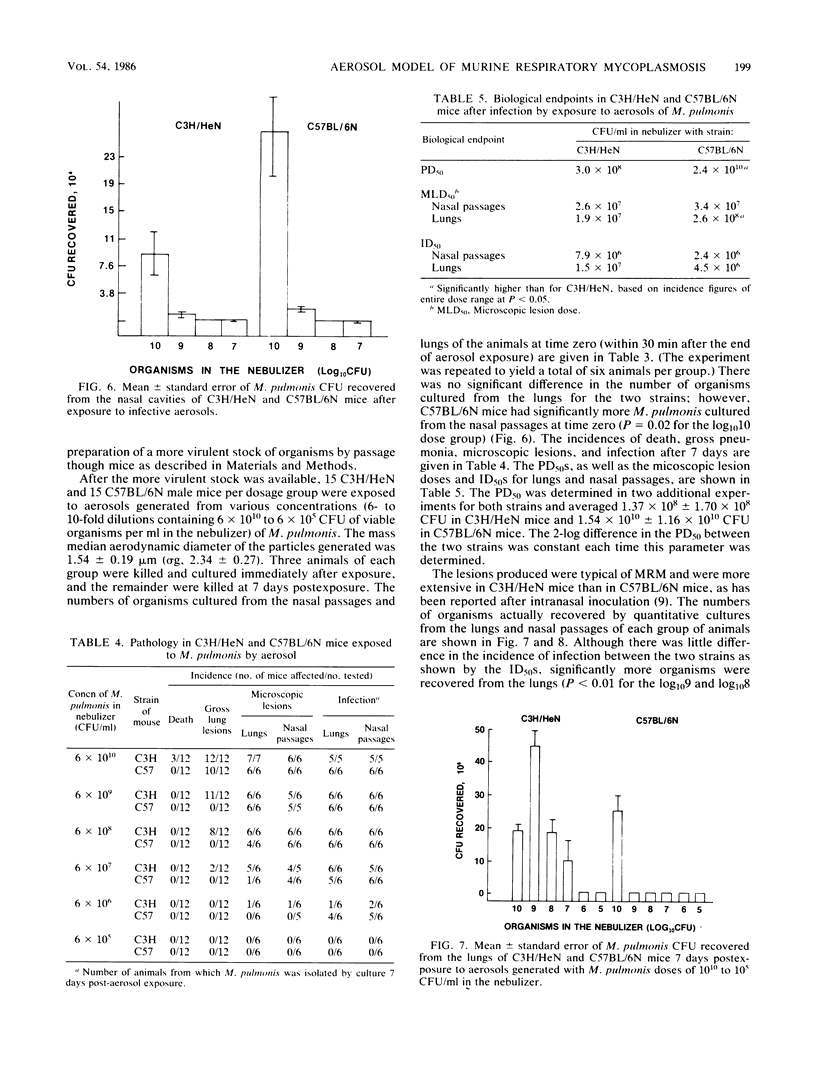

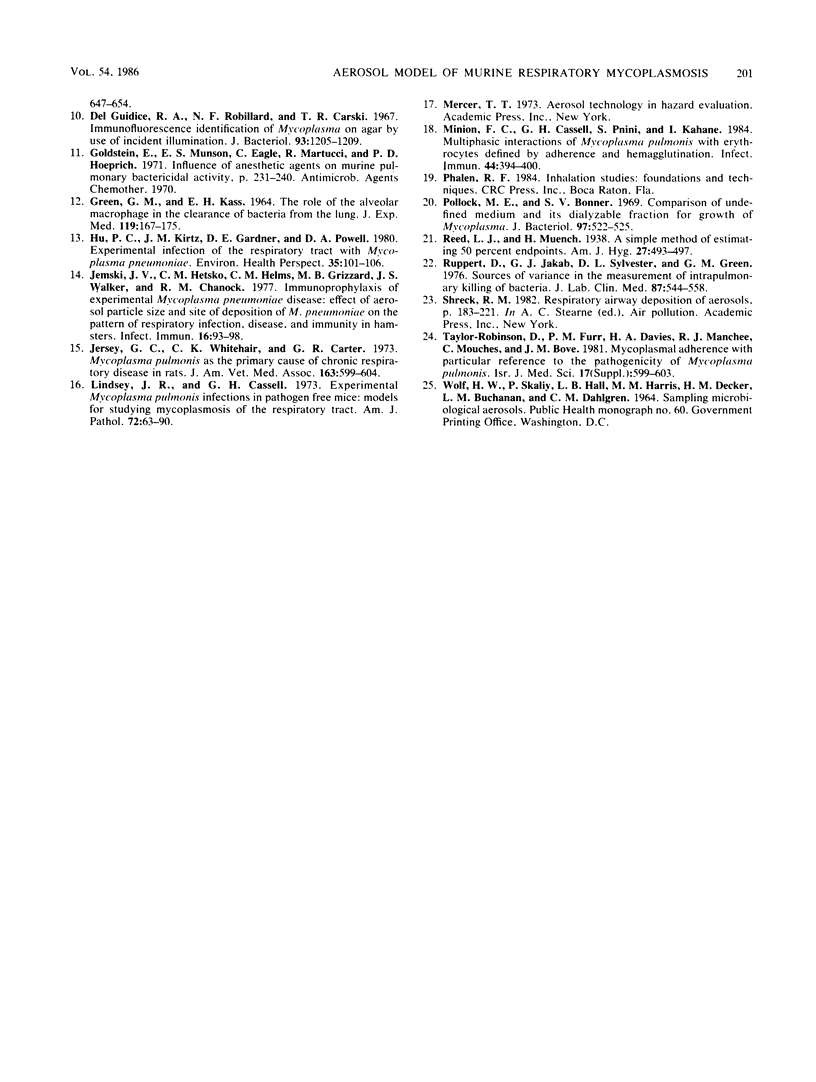
Selected References
These references are in PubMed. This may not be the complete list of references from this article.
- ANDERSEN A. A. New sampler for the collection, sizing, and enumeration of viable airborne particles. J Bacteriol. 1958 Nov;76(5):471–484. doi: 10.1128/jb.76.5.471-484.1958. [DOI] [PMC free article] [PubMed] [Google Scholar]
- Brain J. D., Valberg P. A. Deposition of aerosol in the respiratory tract. Am Rev Respir Dis. 1979 Dec;120(6):1325–1373. doi: 10.1164/arrd.1979.120.6.1325. [DOI] [PubMed] [Google Scholar]
- Broderson J. R., Lindsey J. R., Crawford J. E. The role of environmental ammonia in respiratory mycoplasmosis of rats. Am J Pathol. 1976 Oct;85(1):115–130. [PMC free article] [PubMed] [Google Scholar]
- Cassell G. H. Derrick Edward Award Lecture. The pathogenic potential of mycoplasmas: Mycoplasma pulmonis as a model. Rev Infect Dis. 1982 May-Jun;4 (Suppl):S18–S34. doi: 10.1093/clinids/4.supplement_1.s18. [DOI] [PubMed] [Google Scholar]
- Cassell G. H., Lindsey J. R., Davis J. K. Respiratory and genital mycoplasmosis of laboratory rodents: implications for biomedical research. Isr J Med Sci. 1981 Jul;17(7):548–554. [PubMed] [Google Scholar]
- Davis J. K., Cassell G. H. Murine respiratory mycoplasmosis in LEW and F344 rats: strain differences in lesion severity. Vet Pathol. 1982 May;19(3):280–293. doi: 10.1177/030098588201900306. [DOI] [PubMed] [Google Scholar]
- Davis J. K., Delozier K. M., Asa D. K., Minion F. C., Cassell G. H. Interactions between murine alveolar macrophages and Mycoplasma pulmonis in vitro. Infect Immun. 1980 Aug;29(2):590–599. doi: 10.1128/iai.29.2.590-599.1980. [DOI] [PMC free article] [PubMed] [Google Scholar]
- Del Giudice R. A., Robillard N. F., Carski T. R. Immunofluorescence identification of Mycoplasma on agar by use of incident illumination. J Bacteriol. 1967 Apr;93(4):1205–1209. doi: 10.1128/jb.93.4.1205-1209.1967. [DOI] [PMC free article] [PubMed] [Google Scholar]
- GREEN G. M., KASS E. H. THE ROLE OF THE ALVEOLAR MACROPHAGE IN THE CLEARANCE OF BACTERIA FROM THE LUNG. J Exp Med. 1964 Jan 1;119:167–176. doi: 10.1084/jem.119.1.167. [DOI] [PMC free article] [PubMed] [Google Scholar]
- Hu P. C., Kirtz J. M., Gardner D. E., Powell D. A. Experimental infection of the respiratory tract with Mycoplasma pneumoniae. Environ Health Perspect. 1980 Apr;35:101–106. doi: 10.1289/ehp.8035101. [DOI] [PMC free article] [PubMed] [Google Scholar]
- Jemski J. V., Hetsko C. M., Helms C. M., Grizzard M. B., Walker J. S., Chanock R. M. Immunoprophylaxis of experimental Mycoplasma pneumoniae disease: effect of aerosol particle size and site of deposition of M. pneumoniae on the pattern of respiratory infection, disease, and immunity in hamsters. Infect Immun. 1977 Apr;16(1):93–98. doi: 10.1128/iai.16.1.93-98.1977. [DOI] [PMC free article] [PubMed] [Google Scholar]
- Jersey G. C., Whitehair C. K., Carter G. R. Mycoplasma pulmonis as the primary cause of chronic respiratory disease in rats. J Am Vet Med Assoc. 1973 Sep 15;163(6):599–604. [PubMed] [Google Scholar]
- Lindsey J. R., Cassell H. Experimental Mycoplasma pulmonis infection in pathogen-free mice. Models for studying mycoplasmosis of the respiratory tract. Am J Pathol. 1973 Jul;72(1):63–90. [PMC free article] [PubMed] [Google Scholar]
- Minion F. C., Cassell G. H., Pnini S., Kahane I. Multiphasic interactions of Mycoplasma pulmonis with erythrocytes defined by adherence and hemagglutination. Infect Immun. 1984 May;44(2):394–400. doi: 10.1128/iai.44.2.394-400.1984. [DOI] [PMC free article] [PubMed] [Google Scholar]
- Pollock M. E., Bonner S. V. Comparison of undefined medium and its dialyzable fraction for growth of Mycoplasma. J Bacteriol. 1969 Feb;97(2):522–525. doi: 10.1128/jb.97.2.522-525.1969. [DOI] [PMC free article] [PubMed] [Google Scholar]
- Ruppert D., Jakab G. J., Sylwester D. L., Green G. M. Sources of variance in the measurement of intrapulmonary killing of bacteria. J Lab Clin Med. 1976 Mar;87(3):544–558. [PubMed] [Google Scholar]
- Taylor-Robinson D., Furr P. M., Davies H. A., Manchee R. J., Mouches C., Bove J. M. Mycoplasmal adherence with particular reference to the pathogenicity of Mycoplasma pulmonis. Isr J Med Sci. 1981 Jul;17(7):599–603. [PubMed] [Google Scholar]


